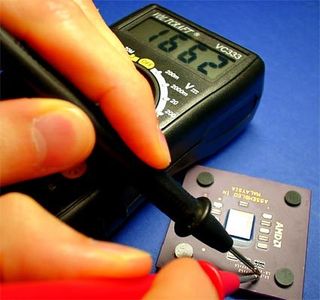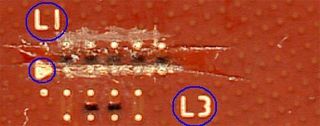Plastic Surgery: Releasing The Athlon XP To Hit 2000+
Why The Pencil Trick Doesn't Work
Unlike the conventional Athlon (ceramic substrate with a Thunderbird core), on which the L1 contacts can be connected with a pencil stroke, AMD has put more work into protecting the Palomino's multiplier. While the resistance between earth and L1 (bottom row) approached 'infinity' on the old Thunderbird Athlon, we measured a resistance of 945 Ohm (about 1 k() on the Athlon XP (Palomino core, organic substrate).
These measurements show why the pencil trick won't work: if the L1 bridge was closed with a pencil stroke, the resistance provided by the graphite would still be too high. The internal pull down resistance ratchets the signal level down so far that the CPU would never interpret the contact as a closed bridge. In other words, AMD knew that its new feature would hinder overclockers. The only way around it is to use a substance with a minimal contact resistance, namely, conductive silver lacquer, which you can get at an electronics store.

The pull down resistance between a grounded point and the L1 contacts stands at about 1 Kilo Ohm - the pencil trick is a no-go!

An old Athlon with a Thunderbird core: the resistance in the L1 contacts, which were connected using a pencil, is higher than 1 Kilo Ohm - however, the CPU still doesn't have an internal pull down resistance.

Another measurement showed that the direct contacts on L1, L3 and the triangle on the left (in blue) are grounded. Under no circumstances should these points be connected to the L1 bridges with the silver lacquer - it would cause every attempt at closing the bridges to fail.
Stay on the Cutting Edge
Join the experts who read Tom's Hardware for the inside track on enthusiast PC tech news — and have for over 25 years. We'll send breaking news and in-depth reviews of CPUs, GPUs, AI, maker hardware and more straight to your inbox.
Current page: Why The Pencil Trick Doesn't Work
Prev Page Step By Step Next Page Here's The Trick - Masking The ContactsMost Popular

